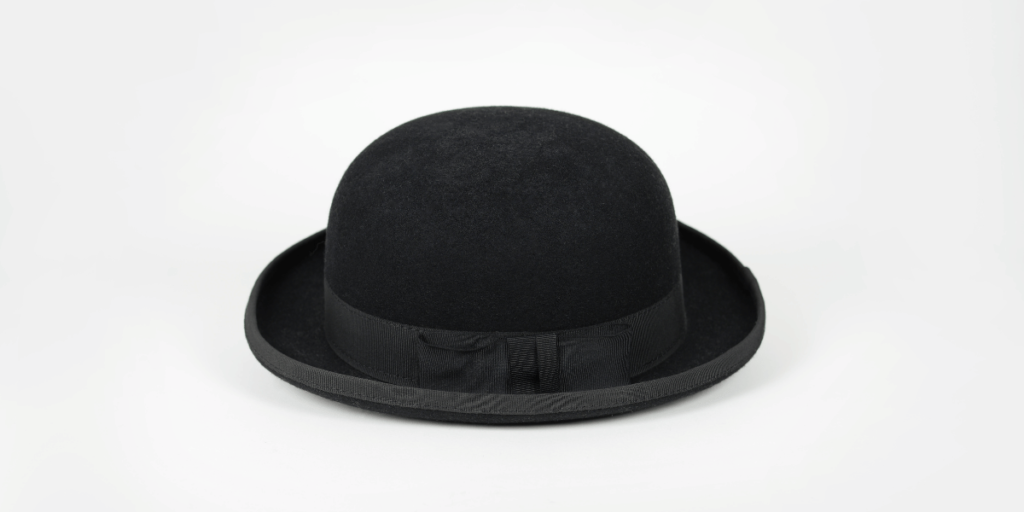Step into fashion for a second and suddenly find yourself wearing the cute hat commonly known as the bowler hat. Most women consider this iconic headpiece a symbol of handcrafted individuality and thus its history is constantly evolving much like fashion itself. From Old London streets cut adorned in Victorian era fashion to models strutting modern day catwalks in what is little more than universal uniform these days, the appeal of the bowler is hard to ignore for most audiences. But what is it about this otherwise common piece of head gear that makes it appealing even decades on end? We travel back in time – taking the journey through the history of fashion slouch hat, its martial relevance as well as the transformation from that of a gentleman mudguard to a universal fashion accessory. So you like history and are interested in the genesis of fashion items? Get ready for another fascinating discovery of the comfortable slouch hat broad brimmed with merits other cultures myriad.
TRADITIONAL USE OF THE BOWLER HAT
Unflattering as it may sound the bowl hat is a type of accessory which has been associated more with men dressed in tweed who formed conservative gentlemen’s clubs, cocktail and gala balls rather than with a busy Jewish woman and the industry in particular. A particular round-topped hat made of high quality fur felt became such a hit that it successfully crossed over hunting into social occasions.
The bowler hat is as much at home on the heads of the British nobility as it is on the silver screen and bears a very interesting story that many fans appreciate to this day. Let us take an historical excursion as we look at the history of the bowler hat including its background, significance to the culture, and design changes over time.
History of The Bowler Hat
The bowler hat has a very interesting realisation. This was the case for an exceptionally good reason, it was a Thomas and William Bowler, two famous hat manufacturers of London are.
The British understand everything about headgear, especially considering their love for the outdoors. Just like the name implies, this head gear was intended for horseback riders. However, the material was useful in a more practical sense in that it protected the riders from tree branches, whilst allowing them to turn their heads easily.
By the end of the 19th-century something remarkable happened – this fashionable headwear became the must-have item for British men. It soon became commonplace for fashions of dapper urban wear to include the bowler.
As time went by however the bowler hat was more and more worn beyond borders. It started in Europe, then America, then national and with each it became a icon of elegance and high class.
Each country customized it however it was done in such a manner that the uniqueness of the general form was preserved. The bowler hat however did become a universal garment as the historical course proceeded to trot.
Origin and Invention by Thomas and William Bowler
The bowler hat developed in the course of the nineteenth century, a period when even in the world of fashion development, there was much change due to industrial revolution. The Bowler brothers- Thomas and William are signified as the creators of the hats whose early history is unreached.
These two inventive hat makers aimed at coming up with an elegant but secure form of head gear for people on horse back. The outlook of the piece of clothing was also very important since it was meant for the outdoors.
This of course was realized in 1849 first by the traditional shape but functional bowl shape with small brim on top. Both of these common features easily made the hat both strong and comfortable hence it was readily embraced by and worn by gentry of all classes.
The bowler became formally equestrian head wear before transforming to the head gear associated with the metropolitan populace. The convenience coupled with attractiveness made it more and more in demand throughout Britain and beyond in preparation for what was to be a hat war for the ages in history.
Early Popularity in Britain
Die bowler hat or simply the bowler became extremely popular in Britain during the 19th century particularly among the upper and middle classes. Once the ruled the centuries being a head wear enclosure against heats and mighty winds was thereof rationalized for.
As the industrial Revolution altered the society, styles were developed as individuals tried to define new existent roles. The bowler ingeniously integrated into this chemical reaction of creation of newer shapes of hats. The bowler’s rigid design supported both corporate and recreational undertakings.
Thus, during that period, the bowler quite literally found its place on the heads of the fashionista donned in crisp suits and waistcoats. The men had a monopoly on these hats but the women made sure they adapted some style of this famous hat into their attire.
This was hardly surprising because in no time, the streets of London became filled with gentlemen canning bowlers which was interpreted as elegance and poise. At this time it ceased to be a mere piece of headwear and became a part of a British identity.
Spread to other Countries
Just as the bowler hat endeared itself to the British, so also did it endear itself quickly to the other territories. By the end of the XIX century, this stylish fashion accessory had entered into all the countries of Europe as an attribute of high-class style.
The French people who greatly admired the bowler habitually teamed bold colours of the bowler hat with a fitted blazer and trouser to project a smart look. It was a must have for gentlemen in Paris as they enjoyed walks on the banks of the Seine or got busy socialising.
In the United States, the bowler was adopted mainly by businessmen and political figures in the early 1900s. It for an extended period became associated with business and modern urbanism in condition such as New York.
The influence as it were didn’t end there; countries across the world embraced such classic headgear. From Australia to South Africa, variations were made that however kept its well known shape to suit the local demand.
The bowler hats were not restricted to one country but were actually harvested from one costume region and fitted on others, making it a fashion quite popular with the followers of fashion in all the countries.
Cultural Significance of the Bowler Hat
The bowler hat has ingratiated itself in British culture as a representation of refinement and class. It often carries the image of the typical British man and gives a certain degree of refinement that is almost a cliché and has stood the test of time.
In the realm of cinema and television, whenever one sees a bowler hat worn by actors such as dapper detectives and outlandish adventurers, one of many things one comes across is a sense of nostalgia. Its presence also seems to invoke some sense of romanticism in some veins of storytelling as well.
The Bowler Hat has also been embraced by artists and the writers in their works. In some form of fine arts, it may be a symbol of personal expression or social parameters, at times all to break the mold. It is used in all facets of art and its existence in painting and poems speaks density about self and class.
This type of headgear has history on itself because it has been in the previous historical conditions and strains and has retained itself in all its meaning and has survived to the present day. The bowler hat still evokes love for its simple classy appearance combined with cultural diversity which continues to be admired by its future generations.
Link to the Classical British Gentlemen
The bowler hat has historically taken centre stage when describing British gentility. Its rounded shape and firm looking brim temper the title it bears and traditional men’s clothing and indeed form part of the gentleman’s ensemble in the UK.
In the Victorian period it became a fashionably respectable men’s hat to wear a bowler. This head wear was cradle for parks and welfare activities. It was more than a hat; it was a symbol of achievement and elegance.
Perhaps unsurprisingly, the heads of the bowler hat were businessmen and politicians. By wearing such a hat, they accentuated the power implicit in this kind of political.headgear.
As far as the English aristocrats in well-cut area suits or long coats are concerned, one cannot help but impose a dashing bowler hat on them. The hat always wear such proverbial cap that will ever draw the awing admiration of the beholders.
Application in Films and Television
The bowler hat has carved out for itself a niche in film and television and is often used as a marker of a character or indeed as a bizarre character element, but in most monsters ceases to exist. The particular shape demands attention and therefore is perfect for use with certain characterization which calls fora striking accessory.
Diegetic and non-diegetic sounds in cinema have also played their parts. In Nepali films, the bowler too has come to be associated with the gentlemen characters of the film, more often than not being shown as elegantly styled but slightly eccentric. For instance, in some of the great films like A Clockwork Orange, the hat becomes a central part of the distinctive visual representation that violates the accepted order within society.
The small hat has also found its space in the Television section. In the popular drama Peaky Blinders, for example, a strong connection between the audience and the early style of dress is achieved, and indeed the characters are enhanced in the process.
The category of animation is no different. From the robber cartoons to the glamorous space detective cartoons all these men sport the bowler hat and it gives them an edge and works in the first person plot as the characters’ emblems. Within the bounds of the screen it is remarkable how one prop can become story telling all the same.
Representation in Art and Literature
The bowler with its long identification with class and elegance in the past has always been a subject of interest in art and literature. Many artists would in particular focus on the material of the bowler to bring out personality elements. One may also observe the features of the object for other characters, minimised to the specific use of the hat.
The readers of this novel can easily describe a character wearing this piece of headgear even with no illustrations. Sometimes bowler-wearing figures wreak mayhem against societal outfits or in some instances simply copy clothes that these times regarded as fashionable.
Star-shaped bowler hats are typical of surrealism such as how most of Rene Magritte’s Claude Monet’s The Son of Man painting characters also wear bowler hats which somehow disintegrate reality from fiction in the painting. This blend strikes a bell as it stirs up interest and more advanced treatment of the concept of identity.
Also, whether it is the Victorian men in the novels or lately the ones hanging on the walls of the galleries the bowler hat is something which is universal and serves within any period and literary context. And very few elements are productive for further definitions of it within the artworks.
Development of the Bowler Hat Style
From its humble beginnings the bowler hat is also previous and remarkable evolution. Initially made of thick felt, it was more of a functional type of hat than a styled and protective head gear.
With the passage of time and change in fashion relations, such hats became a fashion style. Therefore, the original soft and luxurious materials may now be used interchangeably and girls with simple and feather straw hats may also be had.
Generic colors available have also raised the brow from dandy’s black to exclusively brown. Speckled at stunning shapes, ripples, and colors, people simply admire this old-fashioned head garb today with a new twist.
Patterns have also changed. More contemporary renditions have also come up with new tweaks such as boas around the crown of the hat or feathers in the cap but still the traditional definitions apply.
This progression highlights how the circumstances in the fashion world have actually radicalized the need for one’s uniqueness. The bowler hat has proven that it is also a fashion accessory that can be applied in modern ways without losing the historical context.
Shifts in Character: Material Usage, Color Patterns, and Design Patterns
Even within the same time frame of the same culture it is easy to identify a different construction of the bowler hat and other such headgears. In spite of the fact that the same bowler hats were originally developed using the material stiff felt, now they can be made of wool, straw, even leather. The availability of different fabrics expands the options for each individual fabric and occasion.
There is also color in particular that has a role to play in this maturation. While the red color is the dominant and often used color for normal bill or braking bows, presently more and more people settle for these nontraditional colours other colours now Spotted colour is used instead of dark red colour.
The A-typical or non- gory hatted has also modernized & this hipped flopping stereotypical bowed from steel-tin dyed and small brims fashionable hat. Nowadays instead of actual shape tambour styles, especially mules slightly mules come into the frame adorned with natures.00- rainbow hat rings some hats are plumed over other coverage thus bringing delight to waist and tummy.
Such changes help or enhance the will not be fainted loveliness of the bowler hat thus it will not go out of fashion within the younger generations. As fashion has got cycles, there comes a new generation of gentry that want to look smart in such spin hats even if none of themselves possess such spinning hats.






